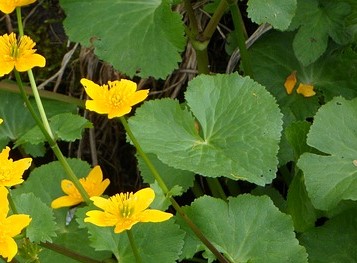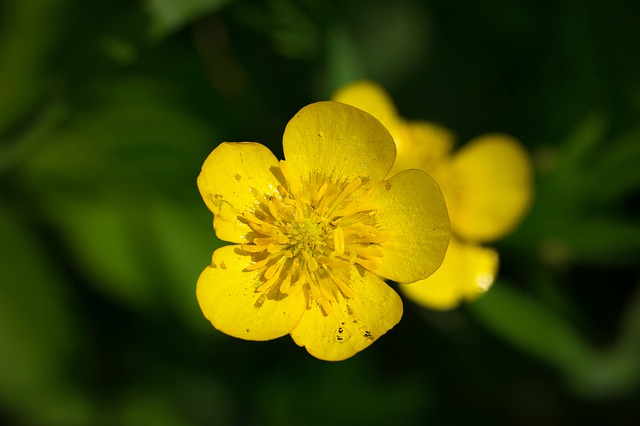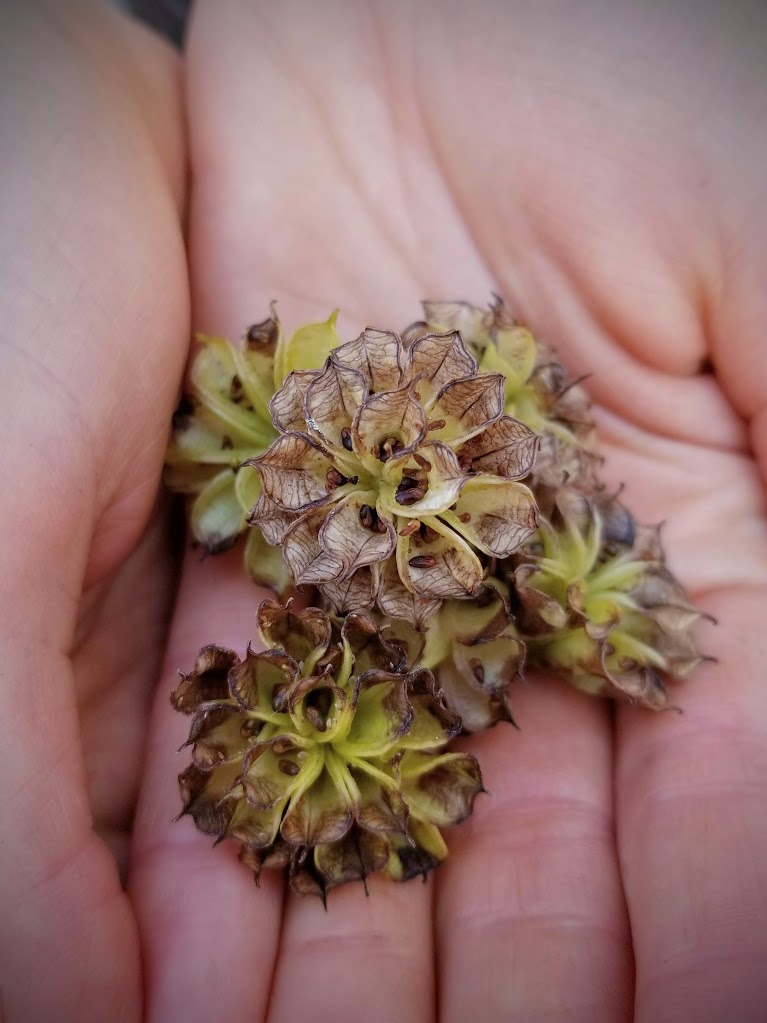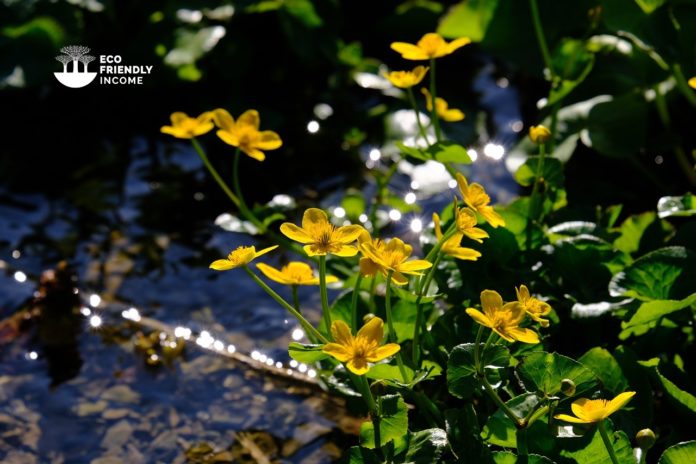A field guide on how to identify & propagate Marsh Marigold (Caltha palustris), a perennial, water-loving plant hardy up to zone 2.

Hardiness Zone: 2-6

Soil Type: Acidic Clay & Loam.

Water: High, likes wet environments.

Exposure: Full Sun to Partial Shade
How to Identify Marsh Marigolds (Caltha palustris)
Leaves

The leaves of the marsh marigold are typically 2-6 inches long and are orbiculate to kidney-shaped with a crenate to serrated margin. They are borne on short stalks in an alternate arrangement, and are green above and paler below.
Flowers

Marsh marigold flowers are about 1 inch in diameter and have five yellow petals. The flowers grow on a tall stem above the leaves.
Flowering Season
Marsh marigold (caltha palustris) flowering season is typically from late April to early June and can persist through summer depending on the conditions.
Habitat
Marsh marigold plants typically grow in wetland habitats, such as ponds, riversides, and lakesides in the boreal forest.
I have seen many grow naturally in small creeks beside culverts.
It’s a plant native to North America, it grows in the majority of the Canadian provinces. It’s also found growing in many of the American States around the great lakes, and even on the west coast in Washington, Oregon, and California.
Here is the USDA Plants map describing its range.
Wildlife Value
Marsh Marigold is a valuable food source for many types of wildlife, including insects, amphibians, and songbirds. The flowers are also a nectar source for bees and other pollinators.
They have an undeniable relationship with frogs. Marsh marigold grows in the environment that frogs love and their foliage provides great hiding spots.
How to Propagate Marsh Marigold (Caltha palustris)
Warning: Marsh marigolds are slightly toxic, it is recommended to wear gloves when handling the leaves, stems, or roots.
There are 3 good ways to propagate marsh marigold, by sowing seeds, by taking root cuttings, or by dividing the plant.
- For sowing you will need to harvest the seeds from the pods that appear later in the season.
- With division you will need to take a wild plant and divide it into 1 or 2 halves.
- With root cuttings you’ll need to dig out a plant and take cuttings from the roots.
Let’s get into detail on how to do that:
How to Propagate Marsh Marigold With Seeds
Seed pods appear on long stalks after the flowers bloom, which is around late May to early June.
Like most native plants from cold regions, marsh marigold seeds will need to go through a cold stratification of 2-3 months.

Harvesting the Seeds
- Cut the seed pods off the flower stems with a sharp knife.
- Hang the stem upside down in a dry place until the seeds fall out.
- Store the seeds in a cool, dry place until ready to plant.
Cold Stratification
Place the fine seeds in a ziplock bag, tag the bag with the name and date, fill 1/3 with sand and moisten. Leave in the fridge for 60-90 days before germinating.
How to Germinate
- Soak the seeds in water for 24 hours.
- Sow the seeds in a pot or garden bed, and cover them with a thin layer of soil.
- Keep the soil moist, and wait for the seeds to germinate.
- Once the seeds have germinated, thin them out so that each plant has plenty of room to grow.
If you have no local source of marsh marigold seeds, you can always order them online here at Ontario Native Plants.
How to Divide Marsh Marigold Plants
When you divide marsh marigolds, the most important is to be very careful when digging them out and to monitor them closely after the division.
The best time to divide plants is in early spring before blooming or late in the summer before dormancy.
- Dig up the entire plant, making sure to get as much of the root system as possible.
- Cut the plant into smaller pieces, making sure to include some of the root system on each piece.
- Replant the smaller pieces in soil, making sure to water them well.
Put your divided plants in a well-lit area but away from direct sunlight. Monitor closely, keep the soil wet, and make sure there is good aeration.
How to Propagate Marsh Marigold With Root Cuttings
Another way to propagate marsh marigold is by taking root cuttings.
They naturally spread by rhizome which means you can take a piece of that rhizome and split it into root cuttings that can sprout clones.
The best time to take root cuttings is from mid-to-late autumn or early winter when plants are dormant.
Here’s how to do it:
- Dig carefully around a plant to spot some rhizomes.
- Cut a section of the root with a sharp knife. Make sure to cut straight across the root so that the cutting has two equal ends.
- Feel free to take a longer rhizome and split it into smaller root cuttings, at least 4 inches long.
- Remove any excess soil from the cutting and then place it in a container filled with water.
- Let the cutting soak in the water for a few minutes and then remove it.
- Fill a pot with moist soil and then place the cutting in it.
- Cover the pot with a plastic bag and then place it in a warm location, best kept in the dark until shoots appear.
- Keep the soil moist by watering it occasionally.
- Wait a few weeks and then transplant the cutting into a larger pot.
That’s it! That should have you covered for any attempt to propagate marsh marigolds! Good luck!
Hey, want to propagate like a pro? Check out our supreme plant propagation guide.
Also, check out other zone 2 perennials in our list below.



